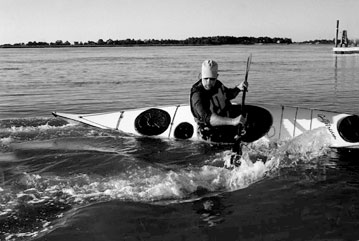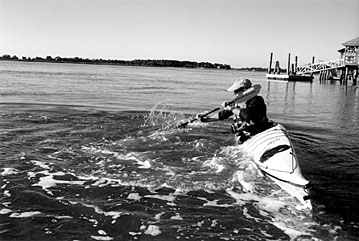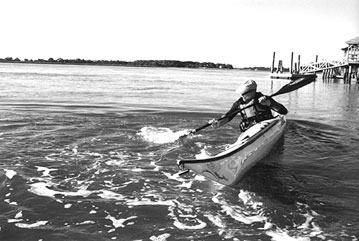Two companies now offer satellite phones that are not much larger than ordinary cell phones, and prices have come down dramatically. And unlike cell phones, satellite phones can work virtually everywhere on Earth.
According to the Cellular Telecommunications and Internet Association, there are currently over 145 million wireless communication subscribers in the U.S. alone. Given the magnitude of these statistics, a significant fraction of sea kayakers undoubtedly own cell phones. What do these kayakers do with their cell phones on paddling trips? If they’re paddling near populated areas, some may choose to take their phones along to keep in touch with family or to call for help in an emergency. Using a cell phone is often not an option on a paddling trip, however. The very solitude kayakers seek when paddling into wilderness areas frequently means spotty or nonexistent cell-phone coverage.
Satellite phones have long been an option for wilderness expeditions of all kinds. Unlike cell phones, satellite phones can work virtually everywhere on Earth. Until recently, they weren’t a good option for recreational sea kayakers due to their high price tag and bulky size. With the introduction of services over the last few years by two companies—Iridium and Globalstar—all that has changed. These companies offer satellite phones that are not much larger than ordinary cell phones, and prices have come down dramatically.
Frequent users can now purchase satellite phones and subscribe to rate plans similar to cell phone plans. Occasional users can rent satellite phones on a weekly basis and pay modest per-minute charges only for the calls they make. Renting a satellite phone and keeping it available only for emergencies can cost less than $75 for a week or $200 for a month, and the cost can be split among all the group members. Professional guides can offer satellite phone use as a valuable and relatively economical service to their clients. Any kayaker who can afford to own a cell phone can probably now afford to rent a satellite phone for the occasional multi-day paddling trip to a remote place. Like it or not, traveling far away from civilization is no longer a good excuse not to stay in touch with a spouse or boss.
A Primer on Satellite Communications
Satellite phones communicate directly with orbiting satellites in space. The satellite acts as a relay station, relaying the signal down to a station on the ground called a gateway. The gateway then routes the call into a standard telephone network.
Satellite phones communicate with satellites in either geosynchronous orbit (GEO) or low-Earth orbit (LEO). Until recently, all satellite phones communicated with GEO satellites, which orbit the Earth at an altitude of 22,238 miles above the equator. In this orbit, they take exactly 24 hours to circle the Earth once—the same amount of time it takes the Earth to complete one rotation. Therefore, from the point of view of someone on Earth, GEO satellites appear to hover motionless in the sky. The high altitude allows each GEO satellite to be in contact with up to one-third of the Earth’s surface at all times. However, to link with satellites at such a high altitude, GEO satellite phones are usually power-hungry and bulky (typically the size of a small briefcase).
LEO satellites orbit the Earth at a much lower altitude of only 1,000 miles or less but have to be much faster; LEO satellites take only about 100 minutes to orbit the Earth. Because of the lower altitude, LEO satellite phones usually require less power and can be smaller than traditional GEO satellite phones. A LEO satellite can communicate with only a small percentage of the Earth’s surface at once and only for a limited amount of time. LEO systems must therefore consist of dozens of satellites in carefully planned formations to ensure uninterrupted coverage, requiring a very large investment to deploy. Since any particular LEO satellite will only be within range of a user for several minutes, they must incorporate complex switching systems to pass phone calls from satellites going out of range to satellites coming into range. Until recently, no one could develop the technology or come up with the investment to make LEO satellite phone systems a reality.
Enter Iridium and Globalstar
In 1998, Iridium launched the world’s first LEO satellite phone service using 66 satellites at a cost of $5 billion. Iridium was followed a year later by a $3.8 billion system of 48 LEO satellites launched by Globalstar. After failing to get the number of subscribers they needed to support their enterprises, both companies filed for bankruptcy. Iridium emerged from bankruptcy in 2001 after a small group of investors paid just $25 million to purchase all the company’s assets. Globalstar is still in bankruptcy, but its investors recently accepted a $55 million offer to purchase the majority of the company’s assets.
The good news for consumers is that both systems still work fine, and now that their operating companies are no longer burdened with significant debt, they’ve slashed prices dramatically. Iridium and Globalstar currently offer the most portable and affordable satellite phones on the market for users in the Western Hemisphere. I tested demonstration phones from both companies over a two-week period while I was kayaking along some remote coastlines in the Pacific Northwest with spotty or nonexistent cell phone coverage.
Coverage Areas
Iridium phones have truly global coverage. They work everywhere from the North Pole to the middle of the Pacific Ocean. They accomplish this feat using intersatellite links. If the satellite a user is communicating with is not in range of a gateway, that satellite will pass the signal on to successive satellites until it reaches a satellite that can downlink to a gateway.
Globalstar doesn’t use intersatellite links. For a call to connect, the user must be within about 900 miles of a gateway. Fortunately, Globalstar gateways are located throughout the world, and Globalstar phones currently work in more than 100 different countries. Globalstar hasn’t established gateways to provide service in the far north or far south (beyond 68° north or south latitude), Southeast Asia, much of Africa or in the middle of the oceans.
Unlike cell phones, satellite phones need a clear view of the sky. They won’t work inside buildings. Large obstructions, such as mountains or buildings, can degrade call quality or even result in dropped calls.
Handsets
Iridium and Globalstar phones are similar in size to handheld VHF radios or large cordless phones. The primary feature distinguishing these satellite phones from cell phones is their large antennas. The antennas fold onto the back of each handset and must be rotated and extended before use.
These phones can handle a bit of rain, but they’re definitely not submersible, so I don’t recommend using them on the water unless it’s an absolute emergency. They are expensive devices, so I suggest storing them in a rigid watertight dry case. If you rent, the dealer may include a custom dry case for an additional fee.
Iridium offers the 9505 phone, manufactured by Motorola. Older models, such as the Motorola 9500, are no longer manufactured but may still be available from dealers for rental or sale. The 9505 weighs 14 ounces and has all the features you’d expect a cell phone to have, such as call waiting, voice mail and memory to store phone numbers. With the antenna stowed, the 9505 measures 6.25 x 2.5 x 2.4 inches. The Motorola 9500 is slightly larger, weighing 16 ounces and measuring 7.5 x 2.5 x 2.6 inches.
Globalstar offers the GSP-1600 phone, manufactured by Qualcomm. It weighs 13 ounces and also has all the features you’d expect a cell phone to have. With the antenna stowed, the GSP-1600 measures 7 x 2.2 x 1.9 inches.
The GSP-1600 works as a digital Code Division Multiple Access (CDMA) cellular or 800MHz analog cellular phone. This gives you the option of using it as a regular cell phone and switching to the satellite network by raising the satellite antenna only when cell phone coverage is not available. Using the GSP-1600 as a cell phone requires a service agreement with a cellular company and a separate phone number and bill. If you rent, using the GSP-1600 as a regular cell phone probably won’t be an option. Iridium no longer enables its phones to be used as regular cell phones.
Making and Receiving Calls
You should have no problems operating either an Iridium or Globalstar phone if you’re accustomed to using a cell phone.
All calls made from Iridium phones are dialed using standard international format. To make a call to a U.S. number, for example, you would enter “001” followed by the area code and phone number. All calls made to an Iridium phone are likewise international calls. To place a call to an Iridium phone from the U.S., you’d dial “011” followed by a 12-digit Iridium phone number. All Iridium phone numbers start with a special country code of 881. This code doesn’t relate to an actual country—it’s just a special access code that tells the long-distance carrier where to route the call.
Dialing rules for Globalstar are the same as landline phones in the country from which the Globalstar phone originates. If you rented or purchased a Globalstar phone from Globalstar USA, for example, the phone would have a standard U.S. number with a Texas area code. To place a call to any U.S. number using a Globalstar USA phone, you would dial “1” followed by the area code and phone number, even if you’re outside of the U.S. To place a call to a U.S. number using a Globalstar phone rented or purchased outside of the U.S., you would use standard international dialing rules.
All calls made from Iridium phones are charged at the same per-minute rate. There are no roaming charges and no surcharges for long-distance or international calls. Incoming Iridium calls are free, but the caller must pay international long-distance rates. If you rent or purchase an Iridium phone, tell anyone who intends to call you to check with their long-distance carrier for the per-minute rate to dial the special “881” Iridium country code. Most major North American carriers charge $2 to $3 per minute to call Iridium phones, but some smaller carriers may charge as high as $11 per minute or may not route the call at all.
Users of Globalstar phones incur roaming charges if they make or receive calls when outside of a home calling area. With phones purchased or rented through Globalstar USA, the home calling area includes the continental U.S., the Caribbean and the Gulf of Mexico.
Call Quality
Voices heard over Iridium had a slightly robotic, synthesized quality. Nevertheless, I could still clearly recognize the people I was talking to by the sound of their voices and had no problems communicating.
Globalstar has a slight edge over Iridium in terms of sound quality: I couldn’t detect any difference between the sound quality of a Globalstar phone and my own digital cell phone.
During the two-week trial period, I did experience dropped calls with both phones. This didn’t happen often. Usually, it happened only when part of the sky was blocked by an obstruction, such as a cliff or structure.
Text Messages and Voice Mail
If you’re kayaking with a satellite phone, the most effective way for others to contact you is to send a text message (called the “Short Messaging Service”). There’s no cost for sending or receiving text messages, and anyone with an Internet connection can send a text message to an Iridium or Globalstar phone by visiting each company’s web site. Once sent, it typically takes 10 minutes for the text message to reach the phone. If the phone is off, you’ll receive the message within a few minutes of activating the phone.
Iridium has the superior text messaging system. Text messages to Iridium phones can be 120 characters in length, and every Iridium phone has its own e-mail address.
Globalstar text messages are limited to only 19 characters in length. Still, this is enough space to send a message such as “Call home ASAP” or some other short page.
Both Iridium and Globalstar offer voice mail, usually for an additional fee. However, your caller will be charged regular calling rates for leaving the message, and you’ll be charged regular airtime rates for checking the voice mail message. Also, if you rent the phone, many dealers ship the phone without voice mail activated or may not offer the service at all.
Battery Life
The rechargeable batteries in both Iridium and Globalstar phones provide talk time similar to that of cell phones. On a long expedition, consider taking along a spare battery. If you rent the phone, many outfitters include a spare battery as part of the package. But even if you have a spare battery, I don’t suggest leaving the phone in standby mode, or you will likely deplete all available batteries well before your trip ends. Turn the phone on only to make calls and check text messages or voice mail. If you adopt this strategy and make only a few minutes of calls per day, each fully charged battery should last for several weeks.
The standard Lithium-Ion battery in the Motorola 9505 provides approximately two hours of talk time or 24 hours of standby time. The standard Lithium-Ion battery in the GSP-1600 provides three-and-a-half hours of talk time or 19 hours of standby time. Higher capacity batteries are available for either unit.
Both phones come with a charger and adapters to plug into wall outlets of different countries. The package often includes a car charger that fits into a cigarette lighter socket. You can also charge your satellite phone with a solar battery charger, but be sure to check with your dealer for compatibility, or you may damage the equipment.
Data Services
Using optional data kits, both Iridium and Globalstar phones can connect with a laptop computer to browse the Internet or to send and receive e-mails. Maximum connection speeds are approximately 10 Kbps (only about 20 percent the data rate of a standard dial-up modem). At this speed, airtime charges can accumulate very quickly. Since this is a much more technical topic and it’s unlikely you’ll lug along a laptop on a kayak trip, I won’t go into any further detail on this capability. Both Iridium and Globalstar’s web sites (listed at the end of this article) have detailed information on the data transfer capabilities of their respective phones.
Rental and Purchase Pricing
For most paddlers, it will make more sense to rent than to purchase a satellite phone. It definitely pays to shop around. I found rental prices on the Internet varying from $40 to $129 a week for the same service. All prices referenced here are subject to change at any time. Prices are expected to come down gradually.
The best rental deals I found were with a company called GMPCS Personal Communications (ph: 954-973-3100; web: www.gmpcs-us.com) in Pompano Beach, Florida. They offer Iridium (Motorola 9500) and Globalstar phone rentals starting at $20 per day or $39.98 per week, including an AC charger and spare battery. Their per-minute rate for outgoing Iridium calls is $1.80. Their per-minute rate for Globalstar calls is $1.59 within the continental U.S. or Caribbean, and their roaming rate is $3.49 per minute. They charge $14.25 for three-day shipping within the continental U.S. The customer is also responsible for return shipping. Best of all, while some dealers charge you from the day they ship the phone until the day it’s returned, GMPCS ships the phone three days before your rental period begins and gives you a grace period of three days to return the phone after your rental period ends. There are many other dealers. If you can locate a dealer in your city (see Satellite Communications in the Yellow Pages), you can escape high express shipping charges by going to the store directly.
If you intend to use the phone for more than three months or you intend to make many calls in a short period, consider purchasing. The retail price of the Globalstar GSP-1600 is around $600, but many discounts are available, and occasionally used units are put up for auction on eBay. You’ll need to pay an activation fee of $50 and sign up for a plan with a 12-month commitment. The plans start at $34.95 per month for 30 free minutes and 99¢ for each additional minute.
Iridium phones and plans are more expensive. The retail price of the Motorola 9505 is nearly $1,400, but again, many discounts are available. I found a limited supply of discontinued Motorola 9500 models available for $850. Like Globalstar, a $50 activation fee and 12-month contract applies. Plans start at $32.95 per month for zero included minutes and $1.49 for each minute. Again, incoming Iridium calls are free.
Iridium and Globalstar also offer prepaid plans. Like prepaid cell phone plans, you can purchase either phone with a bundle of minutes valid for a set period of time (such as 12 months) rather than a monthly plan. This may be a more cost-effective option for some users, such as those planning to use the phone on several different trips but not needing the phone in between those trips.
Which Phone is Best?
The choice between an Iridium or Globalstar phone depends on how and where you intend to use it. If you intend to stay almost exclusively along coastlines in your home area (for U.S. residents, this includes the continental U.S. and the Caribbean), Globalstar is probably the more economical choice. Globalstar also has a slight edge in sound quality, and anyone trying to reach you only needs to dial a regular U.S. phone number.
On the other hand, while Globalstar charges higher roaming rates if you wander out of your home area, Iridium rates are the same regardless of where you go. Iridium also has a superior short messaging service. More important, Iridium phones work virtually everywhere. If you’re looking for a satellite phone to take to the South Pacific, for example, Globalstar currently can’t help you, but Iridium will work fine. Globalstar also has spotty coverage in Alaska and no coverage in Hawaii. Check the Globalstar web site for a detailed coverage map, or ask a dealer.
Whatever phone would work best for your trip, you no longer have to be completely out of touch when you paddle far away from civilization. Satellite phones obviously won’t appeal to all kayakers. For some, getting as far out of touch as possible is one of the principal motivations for paddling into remote areas in the first place. But for others, the ability to talk to loved ones back home or to call for help from anywhere in the event of an emergency will be a great comfort on kayaking expeditions.
Just don’t tell your boss you’ll be available by phone.




 The kayak continues to turn around as the next sweep pushes forward. To complete a 180° turn, the paddler would repeat the last three steps shown here.
The kayak continues to turn around as the next sweep pushes forward. To complete a 180° turn, the paddler would repeat the last three steps shown here. Intrepid Design Statement
Intrepid Design Statement  O
O